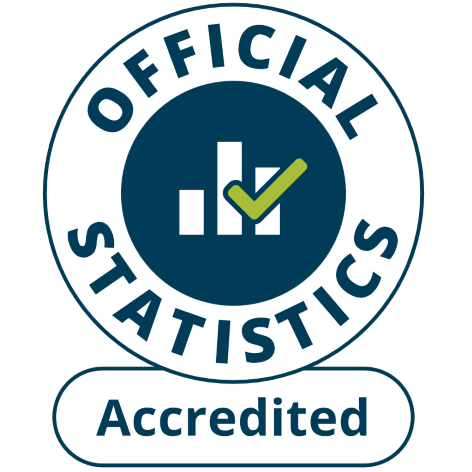Official statistics
The term official statistics comprises official statistics, accredited official statistics and official statistics in development.
All official statistics are produced by crown bodies, those acting on behalf of crown bodies, or those specified in statutory orders, as defined in the Statistics and Registration Service Act 2007.
All official statistics are produced in accordance with the Code of Practice for Statistics and its key principles of trustworthiness, quality and value.
Accredited official statistics, referred to as National Statistics in the Statistics and Registration Service Act 2007, have been assessed by the Office for Statistics Regulation, the regulatory arm of the UK Statistics Authority, as fully compliant with the Code of Practice for Statistics. Accredited official statistics are identified by the following quality mark:

Official statistics in development are newly developed or innovative statistics published so that users and stakeholders can be involved in the assessment of their suitability and quality at an early stage.
Measuring environmental change: Outcome Indicator Framework for the 25 Year Environment Plan
Statement of Voluntary Application of the Code of Practice for Statistics
Although the Outcome Indicator Framework is not in itself an official statistic or accredited official statistics compendium publication, where possible we follow the UK’s Code of Practice for Statistics in its production and in the compilation of the indicator framework and this dashboard.
The code is built around 3 main concepts, or pillars:
Trustworthiness - The focus of this principle is about building and maintaining confidence in the people and the organisations that publish information including that derived from official statistics.
Quality - The focus of this principle is on ensuring that we use data and methods that produce assured statistics.
Value - The focus of this principle is on publishing statistics that support society's need for information, addressing the questions that external users wish to have answered.
The following explains how these pillars have been applied in a proportionate way to enable us to demonstrate voluntary compliance with many parts of the Code, in line with the Guide to Voluntary Application of the Code.
Trustworthiness
[Measuring environmental change: Outcome Indicator Framework for the 25 Year Environment Plan](https://www.gov.uk/government/publications/25-year-environment-plan](https://assets.publishing.service.gov.uk/media/5f840cd5d3bf7f6ba4f45077/25-yep-indicators-2019.pdf) provides references on the sources of all the quoted information. For the most part, the framework draws on formally published official statistics – either produced by Defra or by the department’s Arms’ Length Bodies, often with input from external environmental partners.
This dashboard is not covered by the normal orderly release process required for all new official statistics – primarily because it draws upon already published information. This different release process is also appropriate in that the framework is in essence an operational performance tool, used within the Defra Group to identify the outcomes of delivery to date and to prioritise areas for further action. Hence the draft report is circulated internally in advance of publication.
Quality
Where the statistics used in this report are official statistics, they have an existing quality assessment process. Details on the methodologies used in constructing the underlying statistics are set out in the original publications, which are referenced.
Where there are new indicators in development, these are clearly flagged. We continue to actively develop new indicators together with our existing indicators in conjunction with stakeholders and for those evolving within their source publications as official statistics in development (currently, C6: Diverse seas: status of threatened and declining features, D4: Relative abundance and/or distribution of species, D6: Relative abundance and distribution of priority species in England and J4: Residual waste arising by type and sector). We are requesting user feedback, in particular to gauge the usefulness and value of the statistics. Where appropriate, we will also seek peer review of the methods underpinning our development indicators.
Value
The indicators presented within this report were identified by a cross-disciplinary and cross-organisational team and views were sought from a range of external stakeholders and acted upon.
The Outcome Indicator Framework is intended to inform the separate annual progress report of the 25 Year Environment Plan or the Environmental Improvement Plan, which meets the government commitment to produce an annual assessment of the progress in meeting the objectives set out in the 25 Year Environment Plan or the Environmental Improvement Plan. Regular engagement and regular reviews should ensure that the suite of indicators continues to be informed by and responsive to views from outside government as well as tracking commitments made inside government.
